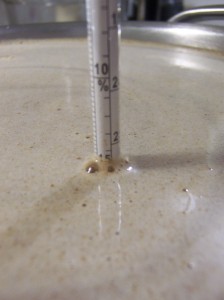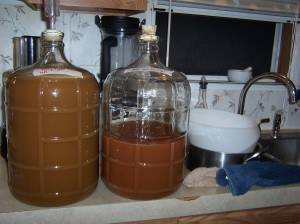I was first introduced to Perry on video, in Hugh Fearnley-Whittingstall‘s BBC show River Cottage. In one of the episodes, Hugh picks some pears, and is taught how to make Perry, which is basically like apple cider except made with pressed pears rather than apples.
I knew I wanted to make another cyser after last year’s Autumn Berry Cyser turned out so well. It was my first successful dry mead, with a delightful tartness coming from the apples I used (that came from Thompson’s Orchard around the corner). I knew cider season was here and I could get great cider from them. But I wanted to try a different additive than autumn berries, since it’s still a wee bit early for those.
My wife recently found some wild pears and brought home a milk crate full. I decided to juice them (thanks for juicing them LM!), and it produced about a gallon of pear juice.
I began my evening by clearing out some jugs and bottling up 3 gallons of Blueberry Nettle Mead and Treequinox Mead:

Once I cleared some jugs, I racked the Raspberry Damiana Mead into them to age and clear. This one is another very interesting brew!
Once I had a clean carboy (thanks for the help LM!) it was time to begin making the Perry Cyser by brewing up 2 cups of black tea, and pouring this into my stockpot, followed by the gallon of pear juice, about a gallon of cider, and about 3/4 a gallon of honey. I then added a bit more of honey and cider until I had 3 gallons of must at 15% alcohol potential:

The must was dark and murky, like the deepest mysteries of autumn distilled:

When I finished, I had a dark mead the color of leaf piles:

It’s still early, so I think the cider will improve in quality in a few weeks. I’ll likely do another cyser soon….
UPDATE, 7 Jan
This is now very dry, at 1% alcohol potential, which means this is 14% alcohol. It’s still quite tart, and once it has a chance to age and clear this will be delicious!
